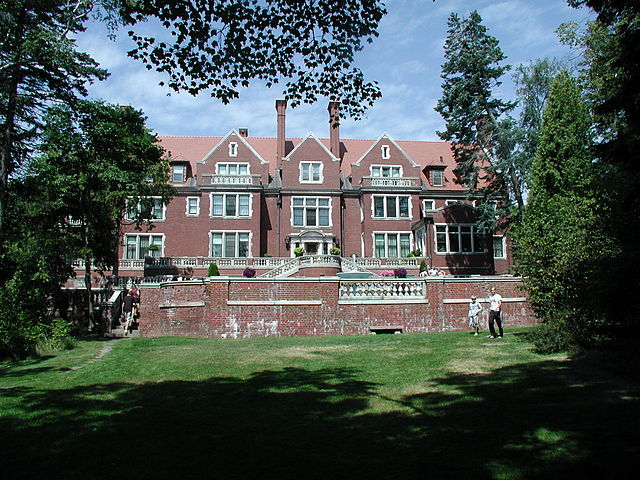The Glensheen Historic Estate is a historic mansion on Lake Superior owned by the University of Minnesota Duluth. Glensheen sits on 7.6 acres (31,000 m2) of lake front property, has 38 rooms and is built in the Jacobean architectural tradition, inspired by the Beaux-Arts styles of the era. The mansion was constructed as the family home of Chester Adgate Congdon. The building was designed by Minnesota architect Clarence H. Johnston Sr., with interiors designed by William French and the formal terraced garden and English style landscape designed by the Charles W. Leavitt firm out of New York. Construction began in 1905, and completed in 1908.
Glensheen’s interior, designed by William A. French exhibits Late Victorian, Arts and Crafts and Art Nouveau styles. French also designed the furniture for the house to coordinate with the style in each room. The rooms are trimmed or paneled in Circassian walnut, mahogany, cypress, fumed oak and American walnut, with the furniture in each room made of the same wood used in the woodwork. The original furniture brought into the house in 1908 and ‘09 remains in virtually the same place it has been for 100 years. Some of the wall coverings and upholstery are also original. The hallways exhibit original stenciling in the Arts and Crafts style as well as beautiful wood carving. Wall and ceiling coverings are made of wool, silk, filled burlap and gold leaf. The doors throughout the home are made of two kinds of wood, with oak on the hallway side and the variety of wood used in the room on the other side. The furniture on the third floor is decorated with ebony inlaid motifs that are repeated in the oak paneled walls. Chester Congdon’s art collection hangs in the home as it did when the Congdons lived there. The collection includes works by American artists Charles Warren Eaton, Henry Farrer, Childe Hassam, Albert Lorey Groll, Hamilton King, Lawrence Mazzonovich, Henry Ward Ranger, Peter Alfred Gross, David Ericson as well as European artists C. F. Daubigny, Henri Harpignies and many more. The house also contains a beautiful silk embroidery done by Japanese artist/embroiderer Yozo Nagara.
In 1968, the estate was given to the University of Minnesota Duluth, which operates Glensheen to this day. At the time, Elisabeth Congdon (youngest daughter of Chester Congdon) was given a life estate, allowing her to occupy Glensheen until her death. It opened to the public in 1979. For years, the third floor and attic were closed to the public due to safety concerns over limited access. However, in 1992, both areas were opened to small group tours. The estate is listed on the National Register of Historic Places.
Aside from its architectural significance, Glensheen was the site of the murders of heiress Elisabeth Congdon and her nurse, Velma Pietila, on June 27, 1977. Roger Caldwell, the second husband of Congdon’s adopted daughter, Marjorie, was charged with the crimes, convicted on two counts of first degree murder and sentenced to two life sentences. Marjorie was charged with aiding and abetting and conspiracy to commit murder, but she was acquitted on all charges. Caldwell”s conviction was overturned by the Minnesota Supreme Court in 1982. He was set to be retried, but pled guilty, submitted a full confession, and was later released from prison. In the intervening years, Marjorie Congdon Caldwell Hagen was twice convicted of arson, serving 12 years in prison and was once wanted for bigamy in North Dakota.
Out of respect for the family, some of whom still live in the area, tour guides are instructed to not discuss the Congdon murders. Even when pressed, staff are at best reluctant to discuss the property”s most infamous claims to fame. Although not likely to be found at Glensheen”s gift shop, curious visitors can pick up a copy of “Secrets of the Congdon Mansion: The Unofficial Guide to Glensheen and the Congdon Murders” at many local bookshops.
The movie, “You’ll Like My Mother” was filmed at the Glensheen mansion. The movie starred Patty Duke and Richard Thomas, released in October 1972.
Discover more from LandmarkLocation.com
Subscribe to get the latest posts sent to your email.

